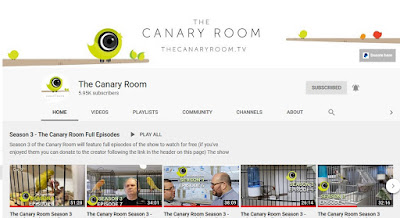2020 was a good year in my bird room.
1) I increased the number of birds in my oldest two American Singer families.
2) This was the second year for a new bloodline, and it gave me several good birds.
3) The newest family line is still in testing stage, but no terrible trait has appeared so far.
4) I expanded into a second canary area in another room... so I was able to separate the hens to another room when I wanted breeding season to end.
2020 also had some lessons to learn.
1) For the first round of all hens, I left each egg under the hen as she laid them. Some breeders I trust do this with success. I found it depended upon the ability of the hen.... good mothers had no problem with a late hatching chick. First time mothers, and nervous mothers, didn't do as well, and I shuffled hatchlings around to foster parents.
>>> I will take out each egg as laid and put in a small numbered cup, as I have done in years past.
*** I did try Julian's (of Julian's Bird Room) Top Tip ( in episode 5 of Season Three of The Canary Room) to take the nest out after the hen laid each day's egg, hang it on the outside of the cage, and return later in the day. I will do that again. HOWEVER, be careful not to knock off the nests! I would not recommend it in small bird rooms or if someone is as clumsy as I am!
2) There were two pairs in the same family line of Opals/Agates that did not produce any keeping youngsters. Feather quality was off, size and shape were poor. I had no idea they would produce such inferior kids. They were culled late summer... and that is the end of that family.
3) I did lose my two oldest American Singers .... but I was consoled by the fact I do have many nice sons and daughters.
4) I did have some thin shelled eggs, so will be adding a calcium supplement to my schedule.
5) I am questioning my use of bread crumbs in my softfood mix... definitely will not be using as much, and not until they are weaned. I think I will be keeping a higher level of protein in the soft food for the youngsters all the way from hatch to end of molting.
>>> The frequency or time of day that I fed eggfood may have been a contributing factor, but I think I did everything okay, even if not on a schedule. Somehow, I wasn't happy with the final size/shape of some of the very last hatches. This will be an area for more notes and thinking over this coming year. I have notes on overuse of bread crumbs in my journals from years past.
6) I am also questioning the correct use of artificial /LED lighting. As well as the newest sets of cages. The cages are enclosed except on the front and each section can be lit with LED cage lights.
>>> I have not proven this theory yet, but I feel the bright light within the cage, resulting in a darker world on the outside .... led to birds not as aware of me/what I did outside their cages. Results were that the youngsters were not as tame, friendly and calm as the youngsters who grew up in a more open wire-only cage.
My Pairings --- Past and Future:
I did alot of reading and thinking about my Breeding Goals, for both now and in future years.
I will write about this in a post in the very near future, with photos of my most promising keeping youngsters!
I have updated the Canary Links page... there are now over 140 web links to good, interesting, and useful information.


































